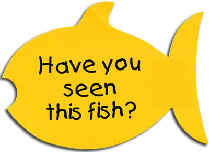What's
it all about?
It's about stream,
river and bathing water quality...
We stencil drains in the street because that's where a large proportion
of urban pollution is flushed into our local streams and rivers, and on
to our beaches.
Did you know?
The
drains in the street outside your door - and all the drains in the
Bourne stream's 12km2 catchment - carry rainwater straight to
the stream, no stopping, no treatment. It's obvious from looking
at many of these drains that some people are in the habit of using them
to dispose of paint, concrete, old engine oil, and probably worse,
perhaps toxic substances. Even by washing your car on your drive
or in the road, soap suds are washed into the stream. All these
actions impact on local water quality, and can harm the wildlife that
lives in and around the stream.
 But before we can act
responsibly we need to be aware of that fact, and of the damaging effect
our everyday activities can have on the local environment. The
Yellow Fish campaign aims to help do that. But before we can act
responsibly we need to be aware of that fact, and of the damaging effect
our everyday activities can have on the local environment. The
Yellow Fish campaign aims to help do that.
Yellow Fish drain
stencilling was first introduced in
Canada in 1991 and has since become adopted by hundreds of local
governments, agencies and environmental groups in the
USA,
Australia and recently
in Scotland and
Korea.
These
are just a few examples of the many initiatives going on in the
developed world, where it has become increasingly obvious that it is no
longer just big industry that is to blame for the majority of water
pollution incidents - it's us at home and at work!
We're not saying that industry is blameless obviously, but
it is now strictly regulated, and more aware of its impacts on air, soil
and water. The actions of environmental groups such as Greenpeace
and Friends of the Earth also ensure that companies such as Esso, for
instance, take a greater care and behave more responsibly.
Now it's our turn - the
householder and the small business owner.
We have the permission of Poole and
Bournemouth Highways departments to stencil drains along our first Yellow
Fish route, which starts at Alderney and more-or-less follows the stream
to Bournemouth Town Hall. |